Climbing Mt Fuji
A Guide to the Top of the Sacred Mountain 🗻
The ascension of Mount Fuji consists of climbing routes on the sides of Fuji-san up to its summit located 3,776 meters above sea level. Its 4 hiking trails are open 24/24, but only during summer time and require advance preparation and reservations. This unique and typically Japanese experience is very popular, its highlight being the viewing of the sun rising or setting from the top of the mountain.
He who climbs Mount Fuji 🗻 once is a wise man, He who does it twice is a fool.
– Japanese proverb
Tokyo aside, Mount Fuji is probably the most famous tourist attraction in Japan. Its stature at the international level is such that many legends and fantasies arose on 'Fuji San' (not 'Fujiyama' which is a misreading of the Japanese characters). Some even say that after climbing Mount Fuji one becomes Japanese.
Since it was enlisted in the UNESCO World Heritage in June 2013, as a "sacred place and source of artistic inspiration", the number of Japanese and international hikers on Fuji-san has been steadily growing each year.
June 2023 marked the 10th anniversary of Mount Fuji’s inscription in the UNESCO Heritage List and the 1rst post-Covid 🦠 season opened to everyone: local authorities dreaded an exceptional wave of 300,000 hikers. However, despite alarming attendance forecast, in 2023 hikers were 221,322 to climb Mount Fuji according to the Japanese Ministry of Environment's statistics. The increase was indeed steep compared to 2022 due to the borders’ reopening, but the figures remained within pre-Covid values. In 2024, the sacred volcano 🌋 received 204,316 hikers.
To prevent the nuisances of over-tourism and guarantee the preservation of the natural site, the 2 prefectures in charge of Mount Fuji’s management, Shizuoka and Yamanashi, have stepped up to regulate more strictly the access to the Yoshida Trail, the most popular, from climbing season 2024.
We put up together a comprehensive guide with pictures and miscellaneous advice for travelers planning to climb Mount Fuji.
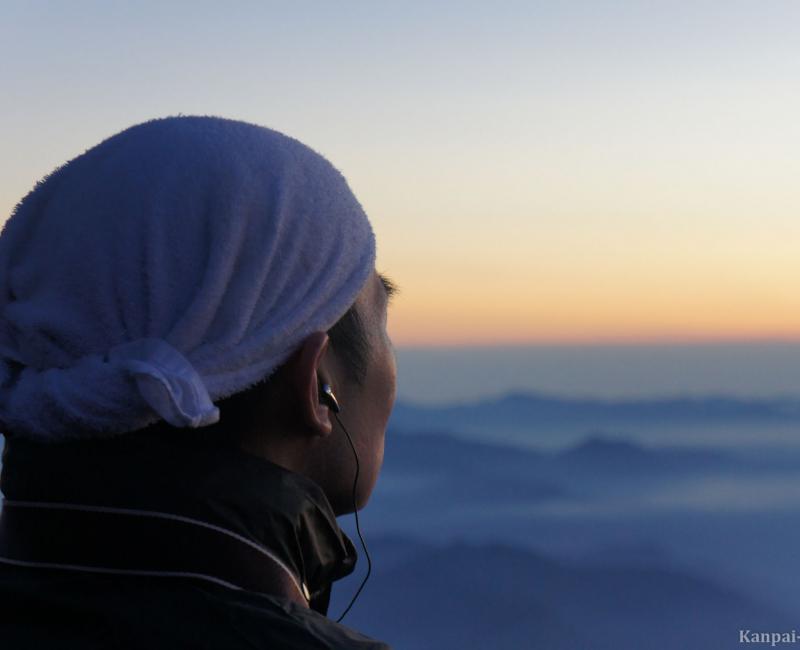
When to climb Fuji-san (season and hours)?
The climbing season is limited to a short 2 months time period in summer, whose exact dates vary for each of the 4 hiking trails to the summit of Fuji-san:
- Yoshida Trail being the easiest is also the most popular route (114,857 hikers in 2024, or more than 60% of the overall visitors number). Its access from Tokyo is easy by bus, and it is open slightly more than 2 months in summer: usually from July 1rst to September 10th. Its starting point is located at 2,305m high (5th station) and it takes on average 6 hours to climb to the top, and 4 hours to go back down the mountain.
- Fujinomiya Trail is the 2nd most popular route (53,218 hikers in 2024, that is to say a little bit more than 20% of visitors). It is opened on average between July 10th and September 10th, and connected by bus to Mishima and Shizuoka stations on the Tokaido JR Line. Its starting point is located at a 2,380m altitude, and climbing to the top usually requires 5 hours, then 3 more hours to go back down.
- Subashiri Trail and Gotemba Trail, are harder routes, and both are opened at the same time as the Fujinomiya Trail. They each have less than 25,000 hikers per season (less than 10% of the total). These hiking trails start lower, at 2,000 meters of altitude and consequently require more time to reach the summit: on average 6 to 7 hours, and 3 hours to climb down.
Regarding the Yoshida Trail and more generally to somehow avoid crowd and congestion, especially when arriving near the top of the mountain, try to avoid going on the weekends, during Japanese holidays, and in particular during the Obon period (mid-August). The less frequented periods are before mid-July and in early September, on weekdays.
Overall, there are 2 trekkers-favorite time slots to climb Fuji-san, to admire from its summit:
- Either sunrise: around 4:30 a.m. in July and 5:30 a.m. in September;
- Or sunset: between 6 p.m. in early September and 7 p.m. in July.
After all, 日本 "Japan" means "origin of the sun", hence the expression "land of the rising sun."
Beside the touristic season, climbing Mount Fuji is not recommended, and even forbidden by local authorities due to the occurrence of many accidents, even with seasoned climbers. Moreover, registration at Yamanashi and Shizuoka prefectures is required, and climbing is at your own risks.
On 2019, October 28, a streamer on the video platform NicoNico, tried the ascension and fell down during his live stream, even though he was a seasoned climber. His body was retrieved 2 days later, 800 meters below, which granted him a Darwin Award.
Snow usually starts to crown Mount Fuji from late October / early November. The first snow of the year is called 初冠雪 hatsu kansetsu.
Transport to the 5th station on the Fuji Subaru Line
A bus makes several round-trips per day departing from Shinjuku in Tokyo, using the "Fuji Subaru Line" road. Reservation in advance is strongly recommended, online via this page. Payment can be made just before boarding the bus, at the bus terminal (in front of the Yodobashi Camera 📷) and the round-trip fare amounts to ¥7,600 (~US$48.54). The bus serves the Yoshida Trail’s 5th station, where most of the hikers begin to walk the trail. While limitations may apply in summer, it is also possible to drive to Mount Fuji (toll fee ¥2,000 / ~US$12.77).
A project of a railway connecting the foot of Mount Fuji and its Fifth Station has been approved by Yamanashi prefecture in February 2021, with an expected round-trip ticket at ¥10,000 (~US$63.87). The construction costs were estimated at ¥140 billion (~894.1 million dollars) for an expected 3 million passengers per year. Construction schedule is to be announced.
Weather on Mount Fuji
Make sure to check Mount Fuji weather forecast a few days before going. Rainy ☔️ days are to be avoided, and naturally, don’t even think about going on typhoon 🌀 days! Note that temperatures at the top of the volcano are around 0°C (32°F), even if it is 30°C (86°F) at its base.
As for Mount Fuji’s visibility index, the sacred mountain’s official website provides real time and 7-days forecasts.
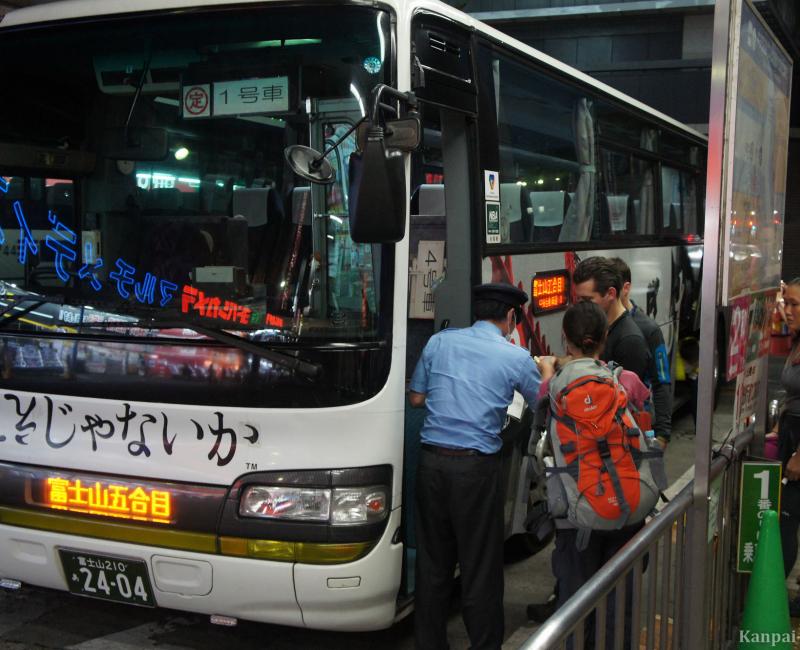
Summer 2025: Conditions and fees
On 2024, May 13, Yamanashi and Shizuoka prefectures announced the implementation of measures that have been carefully considered for nearly 10 years, starting with the 2024 climbing season. In 2025, access to all trails to the top of Mount Fuji require an admission fee to go through the gates installed at the entrance of each walking path.
Yoshida Trail
The new conditions for walking the Yoshida Trail are as follow:
- Installation of permanent toll gates at the entrance of the ascending trail at the 5th station;
- Closing of these gates between 2 p.m. and 3 a.m. (except for hikers who have booked a mountain hut);
- Implementation of a ¥4,000 (~US$25.55) mandatory admission fee per person starting 2025, to pay online in advance only on the Official Website for Mount Fuji Climbing, or on the same day at the gate;
- A 4,000 hikers daily cap on the Yoshida Trail (gates may close before noon if the quota is reached).
The admission fee and the hikers’ daily cap are intended to improve the safety and comfort of the climbers. Visitors will be allowed as follow:
- 3,000 online booking admissions, and,
- 1,000 at the gate.
In the previous climbing seasons, the 4,000 hikers daily cap was reached on average on about 10 days, and up to 17 days in the year 2017, given that a season is about 70 days long or less. Therefore, it may be easier to get a ticket on a weekday at the beginning or at the end of the season.
Admission booking is available online here from May 20th for the season opening on July 1rst. Admission fees are valid only for the selected day, and are not refundable.
The Yoshida Trail is closed at night to prevent access by hikers who haven’t booked a place in a mountain hut, and reduce the risks incurred by the "bullet climbing," that is to say climbing without taking rest, that can lead to acute mountain sickness. The official website provides a list of the mountain huts available for reservation for every trail when climbing at night. Note however that the huts on the Yoshida Trail are usually sold out quite soon after the opening of advance booking (they were full after a few days only in 2024).
Subashiri, Gotemba and Fujinomiya Trails
As for the other trails (Subashiri, Gotemba and Fujinomiya), that are known to be more difficult and therefore less busy, Shizuoka prefecture has set up the same conditions (toll fee and opening hours) as the Yoshida Trail, starting the 2025 climbing season:
- Mandatory ¥4,000 (~US$25.55) admission fee per person;
- Control of a valid booking in one of the trail’s mountain huts for hikers starting to climb after 2 p.m.;
- Online registration of hikers through the Fuji Climbing Pre-registration System / Shizuoka Prefecture FUJI NAVI app, downloadable from its official page.
Regardless the trail chosen to climb the sacred volcano, it is still advisable to pay the additional ¥1,000 (~US$6.39) Mount Fuji Preservation Fee (富士山保全協力金). It can be paid at the same time as the admission fee when using the Yoshida Trail.
In September 2024, Yamanashi prefecture announced a significant 90% drop of the number of overnight bullet climbs following the new hiking limitations set up for 2024 season.
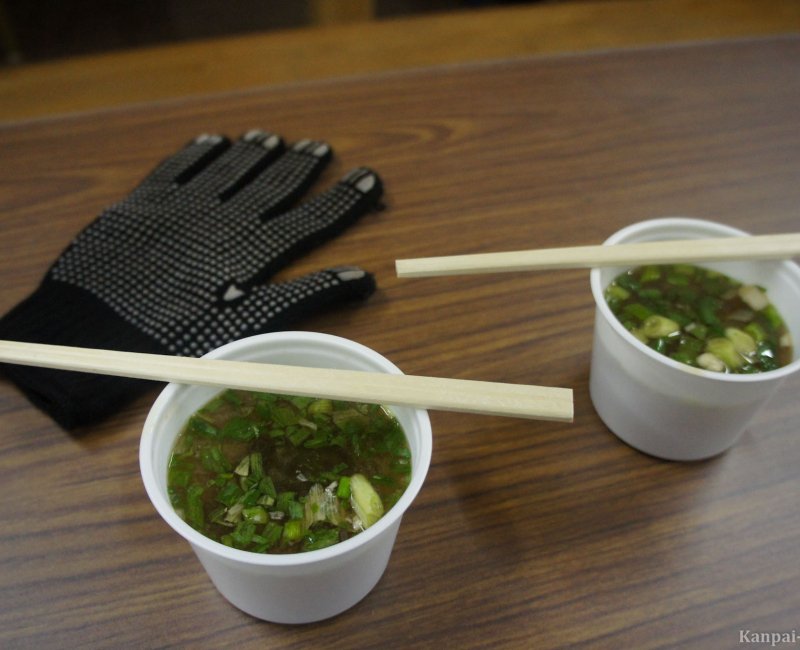
What are the necessary mountaineering gear?
To cut short some misinformation: climbing Mount Fuji is far from a walkover. It requires a good physical condition, some willpower and particularly a good preparation.
Make sure to buy all the equipment you need before reaching Mount Fuji. The highest you climb, the more prices at mountain huts and vending machines skyrocket.
Clothing and accessories
- Several layers of tops, and a windproof raincoat,
- A pair of comfortable trousers (preferably waterproof), on a long underwear or tights if necessary,
- Thick socks and even additional oversocks,
- Hiking shoes are mandatory (don’t even think of climbing in sneakers),
- Beanies and / or hoods are much welcomed items.
Most of the following accessories can be easily bought in ¥100 Shops in Japan, and are therefore affordable:
- A light and convenient backpack,
- A headlamp, very useful when climbing at night,
- Gloves, possibly strengthened for gripping,
- A towel to wipe up sweat,
- Sunglasses and sun screen to use when going back,
- A small bag for garbage (there aren’t many trash cans along the trail),
- Several thousand yens in cash (credit or bank cards are not carried),
- Some painkillers and a can of oxygen just in case,
- Protection gear recommended in case of an eruption: a helmet, protection googles and a dust mask.
Food and drinks
- Cereal / energy snacks, biscuits, fruit purées,
- Onigiri 🍙 rice balls or small sandwiches,
- A lot of water and an energy drink.
- It is also strongly advised against drinking alcohol during the climb.
Photo equipment
- If possible a small, light camera, which is also robust, or a smartphone,
- Avoid bringing a reflex camera or just take one lens,
- Do not bother with a tripod.
Free Wi-Fi on Mount Fuji!
In 2015, the installation of eight free Wi-Fi hot-spots along the ascension trail (of which 3 at the summit) was announced, especially to allow foreign hikers to share their experience in live on the SNS and by e-mail.
Languages available for connection are Japanese, English, Chinese (traditional and simplified), Korean and Thai.
In 2016, the Wire & Wireless company operated the network from July 10 to September 10.
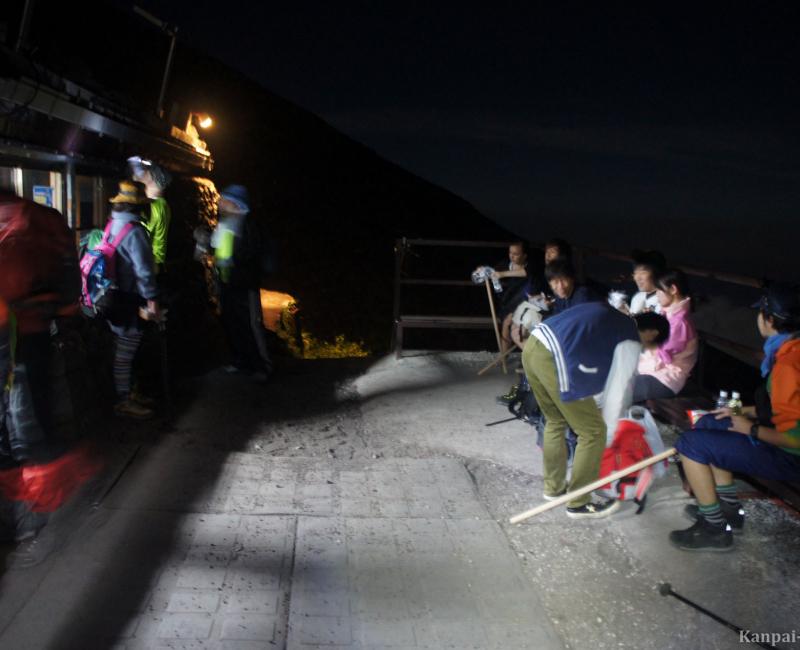
Our experience climbing the Yoshida Trail
The Yoshida Trail consists of 10 stations, completed by mountain huts, the 1rst one being at the base of Mount Fuji (in Fujiyoshida’s Kitaguchi Hongu Fuji Sengen) and the 10th at the summit. The 5th station, from where most of hikers start the climb, is located about 1,500 below and opens an approximately 7 kilometers’ walk.
Keep in mind that if this hike is already quite the challenge, and it can become tedious with walkers’ congestion. Therefore, preferably plan your Mount Fuji climb on a weekday (Monday to Thursday), avoiding bank holidays and Japanese school holidays. While you’ll sweat a lot during climbing, make sure to bring enough clothing so you don’t get cold as you progress in altitude and lower temperatures.
The hike begins by an easy trail, then difficulty rises seriously from the 7th station with a strenuous rocky climb. People who are fit and not subject to mountain sickness can reach the summit in less than 6h (5:15 for us). However willpower prevails since many elderly Japanese make it to the summit. Certainly not as fast, but it shows that who has decided will manage to get to the top.
Each station provides place to rest, paid toilets 🚽, and one or several mountain huts where various snacks are available for purchase: coffee, misous soup, small water bottles, instant noodles, bags of chips. Allow on average ¥300 (~US$1.92) to ¥700 (~US$4.47) per item.
Since 2024, hikers who start a night climbing after 4 p.m. are required to have secured a place in one of the mountain huts in advance. A stay at the mountain hut usually costs around ¥13,000 (~US$83.03) to ¥15,500 (~US$98.99) per person, including a meal (curry rice, gyudon or Japanese hamburger).

Sunrise at the top of the volcano
Climbing Mount Fuji is a fascinating experience: from cordial exchanges during breaks, to murmurs of effort supported by all the climbers on difficult passages. Near the summit, the trail tightens, the silence becomes unreal in the shadow of the majestic Mount Fuji cast by the full moon. Staff of the National Park encourage the hikers and give the time remaining before reaching the summit.
Then the path goes under the last torii ⛩️ gate and reaches the summit where the horizon unfolds, giving an incredible vista on the region of Hakone to Tokyo Bay, surrounded by a sea of clouds. The rising sun offers a wonderful, yet strangely calm sight, and Japanese people start shouting 'banzai!', while their flag is flying in the wind and the national anthem is played through ageless speakers.
After the sunrise, one can walk around the crater for about 1:30 along the Ohachi-meguri Trail and Kengamine Peak, the highest point of the sacred mountain.
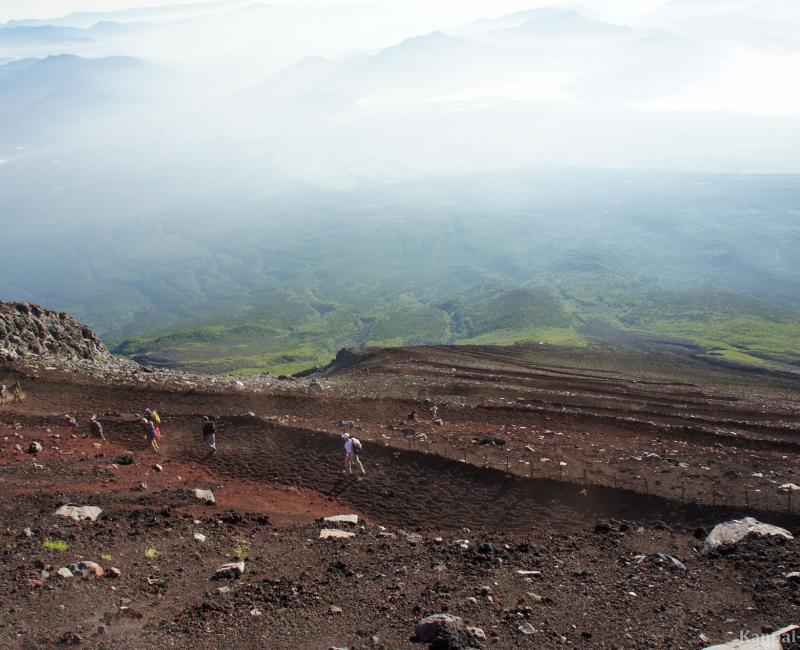
Walking back to the foot of the mountain
The descent is a kind of ordeal in its own right. Fun at the beginning because it's steep and sandy, it soon becomes surprisingly exhausting. With exhaustion from the ascent which mobilized all leg muscles, the strain is now put on the joints, especially ankles and knees. The quadriceps work a lot and we definitely recommend to stretch thoroughly afterwards. It took us 2:30 to complete the descent, but it seemed surprisingly longer probably due to the combination of its monotony, the heat and exhaustion.
Once back at the fifth station, while waiting for the first bus departing for Tokyo at 10 a.m., the place provides the usual souvenir shops and restaurants for tourists. Lively and newly arrived hikers meet the exhausted ones who just climbed down. Aside this crossover, buses unload dozens of Asian tourists who come for shopping and take pictures and selfies. The climb of Mount Fuji is, as a matter of fact, totally out of the picture for them, who are only dressed with light shirts and town footwear.
And they truly are missing out as climbing Mount Fuji is an exceptional experience, essential for any summer traveler in Japan.

